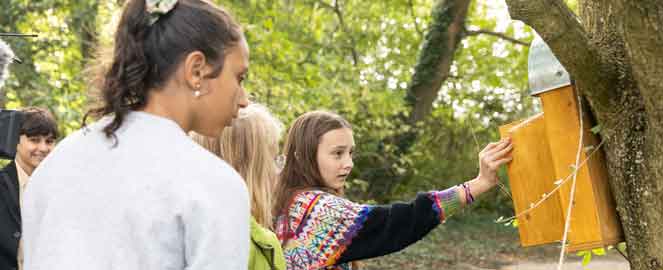EXPLORE THE SCIENCE PARK

In the Science Park, you can go on a quest for science.
Everywhere in the Science Park, you can delve into various aspects of science - from plants to astronomy and mathematics.
Various birdhouses have been placed in the large trees, including a huge one that we hope a barn owl will choose to move into. There are also two bat houses marked with a small bat silhouette, and their openings face downward because bats enter from below.
You can search for our "kukkasser" (curiosity boxes). When you open their the doors, you'll find some facts about things like woodlice or mathematics in nature, along with suggestions for activities you can do in the park. It may seem a bit messy among the trees, but that's intentional as piles of branches and dead trees provide plenty of habitats for insects, birds and other critters.
Part of Science Park includes the Science Cabins. These beautiful two-story shelters are designed to give school students and families during school summer holidays an extraordinary experience.
The Science Park also features several astronomical installations:
The Big Dipper
Consisting of seven stars mounted on top of seven steel tubes, it mimics the appearance of the Big Dipper constellation in the sky. The positions of the seven stars have been precisely measured to match their respective distances from Earth. So, the Big Dipper looks correct when viewed from the designated spot in the park. In the evening, the lights illuminate to show the constellation, revealing that the star in the handle of the dipper is a double star.
The Sundial
Located near the Big Dipper, a linden tree serves as the sundial's pointer. When the sunlight strikes the tree trunk, it casts a shadow on three semicircles with different clock times inscribed. The shadow falls differently during midsummer, midwinter and the equinox due to the Sun's varying path across the sky. The sundial model is a historical way to estimate significant dates for planting and harvesting based on the Sun's position.
Lunar Phases
On the backside of the observatory, there's a model displaying the phases of the Moon in three dimensions. Earth is in the center with eight moon models encircling it. All eight moons are lit by the Sun from the south, indicated by a light colour on the model, while the other part remains dark. Visitors can sit on the Earth in the model's center and rotate it counterclockwise, just as the Earth rotates. This allows guests to see eight different phases of the Moon, including a full moon, three waning moons, a new moon and three waxing moons, accurately representing the Moon's phases during a month.
Meteor Camera
In the near future, a meteor camera will be installed in Science Park to monitor the sky every evening. The camera will look for shooting stars and particularly intense meteor showers that streak across the sky. It will record the paths of these shooting stars in the sky so that scientists can compare them with images from other meteor cameras in Denmark and neighbouring countries, helping calculate the trajectories of these shooting stars. This information may also allow us to determine where a potential meteorite may have fallen.
Enjoy your visit to Science Park, which is open around the clock.